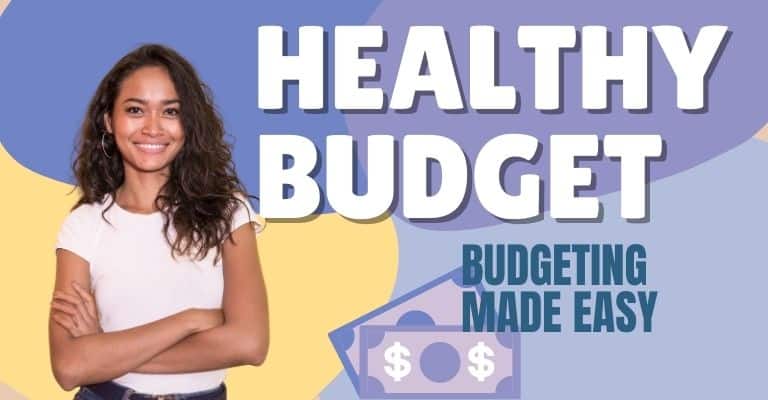10/20 Rule – Effective Budgeting Made Simple

What better way to get your finances in order than with the 20/10 or 10/20 rule?
This method has been used for decades as a simple and effective way to budget and save. The rule’s premise is simple:
Keep your monthly payments under 10% of your net income and total outstanding debt under 20% of your annual after-tax income.
Using this simple system, one can quickly repay debt while building a nest egg for future financial security. Whatever your goals are: Saving for retirement, starting a business, or getting out of debt, this rule will help you get there faster.
In this article, we’ll look at how this system works, why it’s so powerful, and how you can make the most of it to reach your goals sooner.
Disclosure: Some of the links in this article may contain affiliate links, which may provide compensation to me at no cost to you if you decide to purchase. These are products and services I’ve personally used and stand behind. This site is not intended to provide financial advice and is for entertainment only. You can read our affiliate disclosure in our privacy policy.
Tell me more about the 10/20 rule of thumb.
It is called a rule of thumb rather than a mandate because it is just an easy and practical guideline based on sound financial logic. It comprises two simple principles: consumer debt management and debt repayments.
In the most simplistic sense, the 20% part of the rule defines how much consumer debt you can accumulate based on your annual net income.
This excludes housing-related payments, such as a mortgage, property taxes, and home insurance.
Still, it includes all other debt payments, consumer debt, credit card debt, student loan debt, high-interest debt (or low-interest debt:)), and living expenses. Well, you get the idea.
The 10% part of the rule determines your monthly debt payments based on the net monthly income. This keeps your spending sustainable, allowing the rest of your income toward savings and investments or other financial goals such as saving for a down payment for a house or buying a new car.
This system is a straightforward way to quickly get out of debt while also building a financial cushion for yourself in case of unexpected expenses. A solid financial plan for debt management that’s simple to follow.
What are the benefits of the 10/20 rule?
The 10/20 rule helps individuals keep their consumer debt manageable and their finances in order.
- By following this rule, you can achieve financial security and peace of mind without sacrificing your daily spending habits.
- It allows you to build a responsible relationship with money in the long run, saving you from paying high-interest rates that often come with extensive borrowing.
- It also reduces the risk of unexpected medical bills significantly damaging your family’s finances.
- Perhaps the most important benefit of the rule is that it provides a structure for budgeting. Instead of winking at your finances, hoping and praying that you are making enough money to cover your expenses and living paycheck to paycheck, you can now take control of your financial future.
Allocating money towards debt payments helps reduce stress. In addition, a structured spending plan brings peace of mind and benefits your financial health.
What is the difference between the 20/10 and the 10/20 rule?
The 10/20 and 20/10 rules are the same and have been used interchangeably by financial experts and advisors alike.
The 10/20 states that maximum debt payments monthly are no more than 10% of your net income, and total outstanding consumer debt is less than 20% of your annual income.
The 20 percent always applies to the total outstanding debt based on the annual income, whereas the 10 percent is related to the monthly after-tax income.
Is the 20/10 rule realistic?
The 10/20 is an effective budgeting tool; however, it may not be feasible for everyone depending on their financial situation.
For those living paycheck to paycheck or with a limited income, allocating only 10% of their income monthly towards debt may mean sacrificing expenses in other areas, such as groceries or rent.
Meanwhile, for individuals with a higher income, sticking to the 10/20 plan may be more feasible as they can make more significant contributions that will ultimately have a greater impact in the long term.
The key to making the 10/20 plan work for you is understanding your finances and developing a plan accordingly. If you don’t think you can meet the 10/20 standard right away, start by paying off high-interest debt first so you can gradually pay off all debts over time as your financial situation improves.
It’s important to remember that even small amounts add up over time when consistently distributed!
Why are mortgage payments not included in the 10/20 plan?
Mortgage payments are typically not included in the 10/20 budget plan because they are used to help individuals manage their money and reach financial goals.
Mortgages are usually fixed amount that does not fluctuate each month; thus, it is not necessary to allocate a specific portion of income toward them.
Since mortgages typically take years to pay off, it may be more beneficial for an individual’s financial goals to focus on other areas, such as paying off high-interest debt or building up savings with the 10/20 plan.
Additionally, mortgages are usually sizable enough to be considered when developing a budget plan based on the 10/20 model.
In short, monthly mortgages are considered “good debt” and excluded from the 10/20 plan.
What is a healthy monthly budget?

A healthy monthly budget lets you stay on top of your finances and reach your long-term goals. It’s important to allocate a portion of income towards savings, debt, essential living expenses, and discretionary spending.
Savings:
Setting aside 10-15% of your income towards an emergency fund helps to ensure you are prepared in the case of an emergency. Regular retirement account contributions are also recommended, as they will provide additional financial security.
To start saving the easy way, visit Acorns.com. It is a service that allows your money to work for you. You’ll save early and invest automatically; you can sign up in minutes for free. Start saving and investing today. Here’s a link to claim a free $5 when you join.
Debt Repayment:
Allocating 15-20% of your income towards debt repayment can help you become debt free faster. In addition, paying more than the minimum monthly balance can help reduce high interest-rate payments over time.
Essential Living Expenses:
These should make up most of your budget – between 30-35%. In addition, household items such as food, utilities, laundry, and transportation costs fall into this category.
Discretionary Spending:
This category should make up 5-10% of your budget and includes money for fun activities such as dining out or vacation.
By following this breakdown every month, you can save for the future, pay off debt and still enjoy life without breaking the bank!
Key Takeaways
The 10/20 formula of budgeting is a powerful tool to help individuals reach their financial goals. It can be tailored to fit the most financial situation with the right level of commitment and discipline.
By limiting 10% of after-tax income towards debt payments and overall consumer debt under 20% of your annual income, those who stick to the formula will see progress in their financial well-being over time.
This simple method allows users to achieve their long-term financial goals, leaves room to save for an emergency fund, and allows for occasional short-term spending. With the 10/20 formula, everyone has the potential to make smarter choices with their money and build a stronger financial future.
Commonly Asked Questions
With this budgeting principle, how much money should I put into monthly savings and debt payments?
The 10/20 formula is more about debt management than savings. However, a section in this article covers a healthy monthly budget which answers your question: 10~15% on savings and 10-15% monthly on consumer debts.
What are some strategies for sticking to the 10/20 plan when my income is limited?
Sticking to the 10/20 plan can be challenging when your income is limited. However, there are certain strategies you can use to help make it easier to stick to the plan. First, consider setting automatic transfers from your paycheck into savings and debt repayment accounts.
Additionally, prioritize paying high-interest credit card debt before putting money towards other wants. Lastly, track your progress and celebrate the little successes, as these accomplishments will motivate you to continue sticking with the budgeting plan even when times are tough.
Another strategy is to increase your monthly income. Check out our list of 99 best side hustles you can start with to supplement your income.
Are there any risks to following this budgeting strategy?
Following the 10/20 budgeting plan does carry some risks, if you call them “risks.”
For one, prioritizing debt repayments too heavily can leave you with little to no wiggle room for emergencies or other unexpected expenses. Additionally, you may find that your lifestyle can’t keep up with your income if you are too strict regarding budgeting, leaving less disposable income for leisure activities.
It is crucial to analyze how much debt you can afford to take on and adjust the budgeting plan based on your financial situation accordingly.






